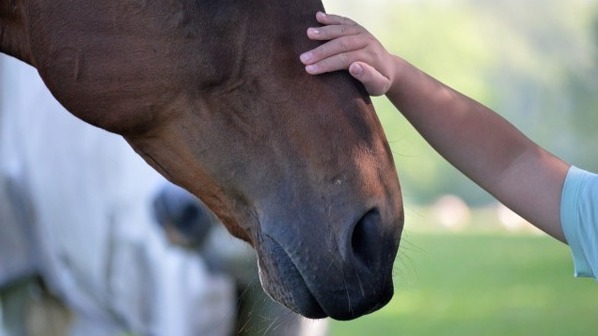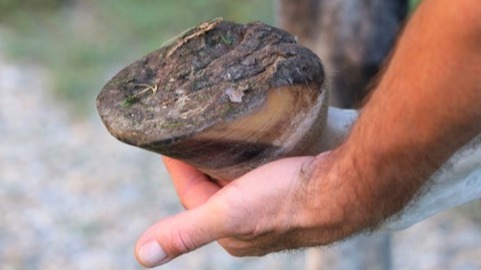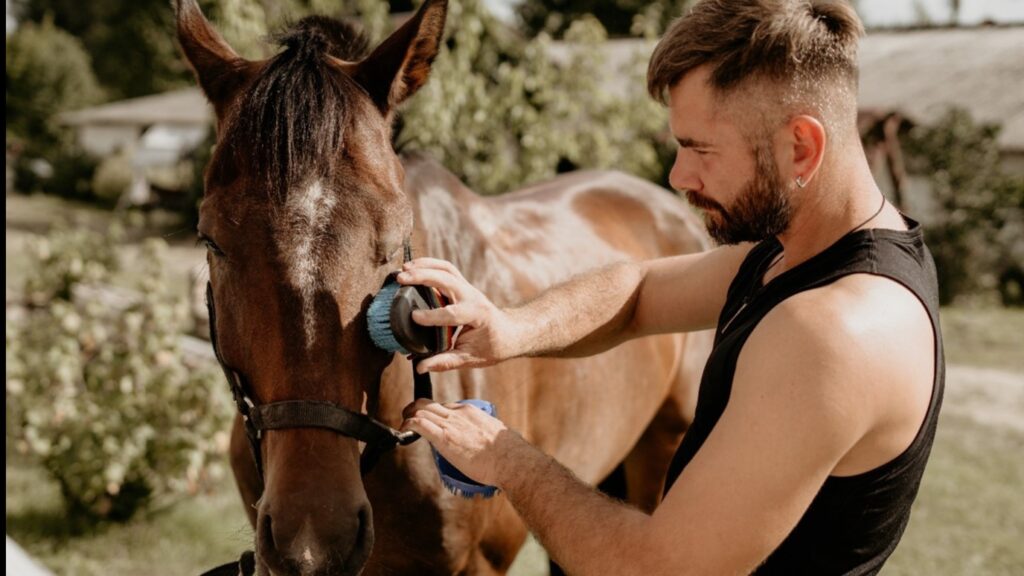Vetting a horse: Your guide to vetting horses

Vetting is an important part of buying or loaning a horse. It is essential for providing buyers with valuable information about the horse’s condition, helping them make informed decisions and manage some of the risks associated with equine investments. It also allows those selling horses to prove the quality of the horses they sell, so it can be a mutually beneficial step for both parties.
To tell you more about vetting a horse, including what happens if a horse has failed its vetting, we’ve put together this guide. We’ll cover:
- What is horse vetting?
- What are the different horse vetting stages?
- 5-stage vetting
- 2-stage vetting
- How many horses pass 5-stage vetting?
- How much does vetting a horse cost?
- Who pays for the vetting?
- Horse vetting and insurance
- What to do if a horse has vailed its vetting
What is horse vetting?
Horse vetting is a medical examination conducted by a veterinarian to assess a horse’s health and soundness on behalf of a potential buyer. It examines the horse’s overall health, conformation, movement, and soundness through flexion tests. Buyers pay for the examination, and the results influence the decision to purchase, negotiate, or walk away from the deal.
Horse vetting is not mandatory by law, but it is a common practice and is typically at the discretion of the potential buyer. It is not a legal requirement, but it is an important and widely recommended step when buying a horse — especially for valuable or performance horses.
What are the different horse vetting stages?

In the UK, there are two main types of horse vetting: 5-stage, and 2-stage. 5-stage vetting involves a thorough evaluation of the horse’s health, soundness, and suitability for its intended purpose. 5-stage vetting is often recommended or even required when purchasing horses for riding or other equestrian activities.
A 2-stage vetting is a more abbreviated and less comprehensive pre-purchase examination for horses compared to 5-stage vetting. It is often used when there is less concern about the horse’s overall health and soundness, and it’s generally quicker and less expensive.
5-stage vetting
Here are the five typical stages of a 5-stage vetting:
- Stage 1: This is a preliminary examination and is usually conducted in the stable. The vet assesses the horse’s overall health, checking for any visible signs of illness, injury, or conformation issues. It may include a review of the horse’s medical history and a brief trot-up in hand to observe its movement.
- Stage 2: The horse is taken out of the stable and assessed for soundness on hard, level ground. The vet observes the horse’s gait in a walk, trot, and canter, to check for any signs of lameness or discomfort. Flexion tests may also be performed at this stage.
- Stage 3: The horse is exercised under saddle or in-hand to evaluate its performance, response to exercise, and behaviour. The vet assesses the horse’s fitness, willingness to work, and general suitability for its intended use.
- Stage 4: This stage typically involves a period of rest after exercise. The vet observes the horse during this rest period to detect any delayed signs of lameness, such as stiffness or discomfort.
- Stage 5: In the final stage, the horse is examined again in the stable. This includes a thorough check of its heart and lungs, a detailed examination of its conformation, and a review of any findings from the previous stages. The vet provides an overall assessment and may offer recommendations based on the findings.
At the end of the 5-stage vetting, the veterinarian will provide a detailed report, often in the form of a vetting certificate, summarising their findings and offering their professional opinion on the horse’s suitability for purchase. It’s essential to choose an experienced and independent veterinarian to perform the 5-stage vetting to ensure an unbiased evaluation of the horse’s condition. You can do this by asking for referrals or using a resource like RCVS Find a Vet.
2-stage vetting
The 2-stage vetting generally consists of these two stages:
- Stage 1: This initial stage typically involves a basic examination of the horse’s overall health and conformation. The vet may check for any visible signs of illness, injury, or conformation issues, as well as inquire about the horse’s medical history. A brief trot-up in hand may be conducted to assess the horse’s basic soundness at a walk and trot.
- Stage 2: In the second stage, the horse is exercised briefly to assess its soundness while trotting or, in some cases, cantering in a straight line on a hard, level surface. Flexion tests may also be conducted to check for any signs of lameness or stiffness. This stage focuses on evaluating the horse’s soundness in motion.
The 2-stage vetting is often used for horses with lower price tags or when buyers have a good understanding of the horse’s history and are less concerned about potential hidden issues. It’s less comprehensive than the 5-stage vetting and may not include assessments of the horse’s fitness, behaviour, or suitability for a specific purpose.
While a 2-stage vetting can provide some information about the horse’s soundness, it is not as thorough as the 5-stage vetting and may not uncover more subtle issues that could affect the horse’s long-term health and performance. Buyers should consider their specific needs and the value of the horse when deciding which type of vetting to pursue.
How many horses pass 5-stage vetting?
The results of a 5-stage vetting can vary widely depending on the individual horse being examined and the specific criteria of the examination. A 5-stage vetting is designed to be thorough and may reveal various issues, some of which might be minor and manageable, while others could be more significant and affect a horse’s suitability for a particular purpose.
The outcome of a 5-stage vetting may fall into one of the following categories:
- Pass: The horse passes all stages of the vetting, indicating that the veterinarian has not identified any significant issues that would affect its suitability for the intended purpose. However, it’s important to note that a “pass” does not guarantee a horse’s future performance or health.
- Conditional pass: In some cases, a horse may pass the vetting with certain conditions or recommendations from the veterinarian. These conditions could involve ongoing monitoring, treatment of minor issues, or specific management considerations.
- Fail: The horse fails the vetting because the veterinarian has identified significant health or soundness issues that raise concerns about its suitability for the intended purpose. These issues might include lameness, respiratory problems, or other health conditions.
The specific pass rates for 5-stage vetting can vary, and it largely depends on the individual horse, its age, history, and the expectations of the buyer. Many horses do pass a 5-stage vetting, but the level of acceptance depends on factors like the horse’s current condition, the thoroughness of the examination, and the buyer’s tolerance for potential issues. Horses that are young, in good health, and have a known medical history may be more likely to pass a 5-stage vetting, whereas older horses or those with pre-existing conditions may have a higher chance of failing.
Vetting is a valuable tool to inform the buyer’s decision-making process, but it’s essential for buyers to carefully review the vetting results and consider their own needs and expectations when making a decision, as a “pass” doesn’t guarantee a horse’s long-term performance or health, and a “fail” doesn’t necessarily mean the horse is unsuitable for all purposes.
How much does vetting a horse cost?

The cost of vetting a horse in the UK can vary depending on several factors, including the type of vetting (e.g., 2-stage or 5-stage), the location within the UK, the experience and reputation of the veterinarian, and any additional tests or services required. Here’s a general estimate of the cost of vetting a horse in the UK (prices may vary):
- 2-stage vetting: This basic vetting may cost several hundred pounds. The price can vary based on location and the specific services included in the vetting.
- 5-stage vetting: A 5-stage vetting is more comprehensive and therefore it is usually more expensive. In the UK, a 5-stage vetting can range from a few hundred pounds to over a thousand pounds, depending on various factors. Some premium services or veterinarians may charge even more.
- Veterinarian’s experience and reputation: Veterinarians with more experience and a strong reputation may charge higher fees for their services.
- Location: The cost of vetting a horse can vary by region within the UK, with prices generally higher in more affluent or urban areas.
- Additional services: If the vetting requires additional tests or diagnostic procedures, such as X-rays, ultrasound, or bloodwork, these can add to the overall cost. The price for these services can vary widely depending on the complexity of the examination.
Who pays for the vetting?
The cost of the vetting, from the veterinarian’s fee to any additional tests or procedures, is typically paid for by the potential buyer. In most cases, it is the buyer’s responsibility to cover the expenses because the vetting is conducted to help the buyer assess the horse’s condition and suitability for their intended purpose, and the buyer incurs the cost to obtain this information.
It’s essential for the buyer to have a clear understanding of the costs involved in the vetting process and to budget for these expenses when considering the purchase of a horse. The results will help the buyer make an informed decision about the horse, including whether to proceed with the purchase, negotiate the price, or walk away from the deal based on the veterinarian’s assessment.
Horse vetting and insurance
You may be asked to organise a vetting before you can take out horse insurance. Some insurers may ask for a 2- or 5-stage vetting, and in some cases may ask for X-rays or a blood test. If your insurer does require a vetting, they may also state how recent the vetting needs to be. Always check the details of your policy to see if you need a vetting and if so, how current it must be.
It’s important you don’t delay getting insurance for the horse as soon as you purchase it. Even if your horse doesn’t need a vetting for insurance purposes, most insurers have a 14-day period during which injury is covered but illness isn’t. By insuring at purchase, you can ensure he’s fully covered as soon as possible, so you have peace of mind knowing you can call the vet without worrying about the cost — and concentrate on enjoying your new horse!
If you choose to have a vetting without insurance, you are responsible for covering the entire cost of the examination. This might include any treatment for health or soundness issues discovered during the vetting if you end up buying the horse, so it’s crucial to carefully review the results and discuss any findings with the seller before finalising the purchase. In the event that the horse develops health issues or experiences lameness shortly after the purchase, you won’t have insurance coverage to assist with veterinary bills or potential treatment costs. It’s essential to factor this into your decision and budget accordingly.
What to do if a horse has failed its vetting
If a horse fails a vetting, it means that the veterinarian conducting the examination has identified significant health or soundness issues that raise concerns about the horse’s suitability for its intended purpose. When a horse fails a vetting, the buyer and seller may enter into negotiations to determine whether they can agree on a revised purchase price or other terms that account for the horse’s identified issues. This can be a way to address concerns while still proceeding with the purchase.
In some situations, the buyer may request further evaluation of the horse’s condition. This could involve additional tests, consultations with specialists, or a follow-up examination after a period of rest or treatment. If the identified issues are deemed too severe or extensive, or if negotiations with the seller do not lead to a mutually agreeable solution, the buyer may choose to walk away from the purchase. In this case, the buyer typically does not proceed with the transaction.
A failed vetting does not necessarily mean that the horse is unsuitable for all purposes. Depending on the nature and severity of the issues, the buyer may consider the horse for a different role or level of activity. For example, a horse that failed a vetting for high-level competition might still be suitable for recreational riding or as a companion animal. It’s advisable to have clear terms and agreements in place between the buyer and seller regarding what happens in the event of a failed vetting before initiating the examination.
It’s important to note that a vetting is not a guarantee of a horse’s future performance or health. Horses, like any living creatures, can have a wide range of health and soundness issues and the specific outcomes of a vetting may vary based on individual circumstances and the terms of the sale agreement. However, vetting can help buyers make informed decisions when purchasing a horse, so it’s an important step in the buying or loaning process.
We have plenty more helpful content for you to browse here at Horse & Country, from horse grooming guides to riding tips and even advice for understanding horse behaviour, plus a huge range of training and learning videos too. We’re also your number-one stop for sports and events coverage, entertainment, and documentaries, so make sure to subscribe to our service today.







